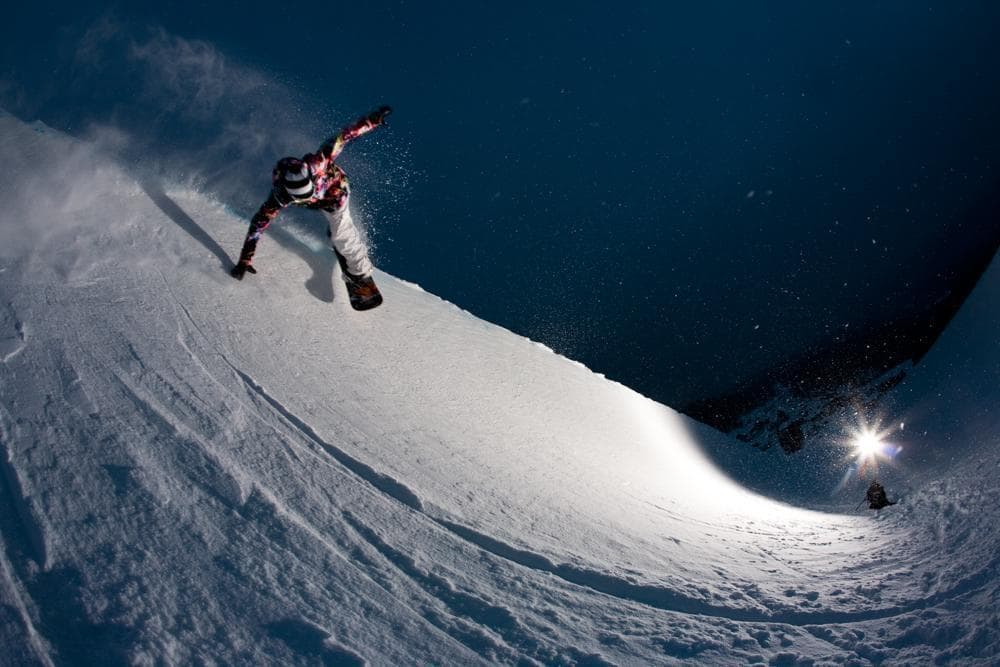Advertisement
Featured Movie
Snowboarder Kevin Pearce Shares Injury And Recovery In 'The Crash Reel'
Resume
Before December 31, 2009, Kevin Pearce was one of the most spectacular snowboarders anybody had ever seen. He'd challenged Shaun White, aka "The Flying Tomato," for the status of top dog in the sport, having won three medals at the 2008 Winter X Games and another one in 2009. He was training in Park City, Utah, for the 2010 Olympics when he crashed.
“I tried the trick and ended up coming down on my front edge and resulted in slamming my head to the sheer ice half pipe and left me in a coma," said Pearce. "So it was pretty intense.”
[sidebar title="Skiing's Controversial Craze: 'Skinning'" align="right"]More and more skiers are skipping the chairlift by putting skins on their skis and climbing up. "Skinning" is generating uphill traffic on downhill slopes, and creating new safety concerns for ski resorts.[/sidebar]After December 31, 2009, Kevin Pearce became, among other things, a case study. He didn't open his eyes for 10 days after the accident. His first memory came a month later.
“At the time his eyes were looking different directions," said Lucy Walker. "He couldn't remember from one minute to the next meeting me, so he’d keep reintroducing himself.”
Lucy Walker is the director of The Crash Reel, a documentary about Kevin Pearce and his family. She met Kevin a few months after the crash.
“His head was shaven and he couldn't read," said Walker. "He took naps all the time. He was very early in his recovery and it was actually amazing to me with these traumatic brain injuries quite how bad they can look and quite what an amazing recovery you can have.”
The Crash Reel includes footage of Kevin and his snow-boarding buddies, who called their group FRENDS, doing various impressive stunts. It also includes a video recording of the crash, and film of the especially difficult time when Kevin — and Kevin alone — thought he would one day return to the half-pipe as a world class snowboarder. In a scene where his doctors urged him to throttle back his expectations, he replied in incomprehension.
“But I kind of don’t understand what you are saying because I felt totally fine and a lot of the things that I'm going to continue to do with my life are gonna be risky."
Many painful months later, thanks in great part to the patience of his family, Kevin finally began to understand not only that he'd never again be a competitive snowboarder, but why it had taken him so long to recognize that fact.
“My brain wanted to tell me that I was fine that nothing was wrong, and that I was going to be all good to get back to this – this sport that I loved so much and I had so much fun doing.”
Perhaps part of what made acceptance so challenging for Kevin was that before his injury, though he knew lots of other snowboarders and skiers had had terrible accidents, he thought he was invulnerable.
“You know, I really did. At that point in my life, it was like nothing – it didn't feel like anything could happen to me. I was so good at what I was doing, and I was so experienced.”
The Crash Reel brings the viewer into the Pearce family dining room, where Kevin's parents and brothers endure his fantasy of returning to competition and gently urge him toward a more realistic appreciation of his future. An appreciation his brain cannot process. Filmmaker Lucy Walker acknowledges that it was the family's strength that enabled her to refrain from stepping out from behind the camera to tell Kevin to relinquish his dream of returning to the podium. The result is a film that's at least as much about what Walker calls "the most functional family I've ever known" as it is about the glory and the risks associated with extreme sports. Still, the experience has changed the way Walker views what Kevin Pearce used to do, and what his friends are still doing, and will be doing for an audience in the millions in Sochi a few months from now.
“When I watch extreme sports my eyes are sucked out of my head,” said Walker. “It’s mesmerizing. It’s dazzling and acrobatic. They’re inventing it as they go along. It couldn't be more thrilling, but there’s a big part of me that sees what they are doing and knows that the stakes are life and death.”
Kevin Pearce's injury was horrendous. But it was not unique. Marc Peruzzi writes for Outside Magazine. He produced a special report on the rise of traumatic brain injuries for the magazine's December issue. Peruzzi has numbers of friends and acquaintances who've suffered terrible accidents, some of them fatal, while engaged in extreme sports that seem to only get more extreme. The first half-pipes in which snowboarders competed were four feet high. As Peruzzi recently told me, the half-pipe in which Kevin Pearce was practicing was 22 feet high.
When I watch extreme sports my eyes are sucked out of my head. It’s mesmerizing. It’s dazzling and acrobatic. They’re inventing it as they go along.
Lucy Walker
Because extreme athletes depend heavily on the endorsement money they get from the companies that make equipment, clothing, sports drinks, and the other products associated directly or indirectly with their heroics, some who see the sports as ridiculously dangerous have blamed the corporations for pushing the athletes to try ever more risky tricks. Kevin Pearce won't go along with that.
“I never had any pressure put on me," said Pearce. "If there was ever pressure it was solely myself putting the pressure on myself and never the sponsors once or my family. Never were trying to push me to do more than I felt comfortable doing. It was always my choice and me wanting to get better and move forward with snowboarding.”
Having spent years filming Kevin and his family, documentarian Lucy Walker is inclined to agree, albeit with reservations.
“I don't see individual evil people luring people to their deaths," said Walker. "But I see an industry that has found itself in a situation where going bigger, doing more – more flips, more tricks, more danger is a part of the excitement and the conversation about safety is not keeping up with the pace of the thrilling evolution in the sport.”
Walker's hope is that the film will teach people about at least minimal safety measures: that helmets and insurance are two good ideas, for example. She'd like to see more energetic efforts to educate athletes about how relatively minor head injuries should be treated. But the triumph of The Crash Reel is the portrayal of a family as its members deal with an extraordinarily difficult set of circumstances. Today Kevin Pearce is part of a campaign started by Lucy Walker called "Love Your Brain." He speaks to groups about what he has learned from his experiences as an athlete, and as a former athlete recovering from traumatic brain injury.
The Crash Reel opens in theaters on December 13.
This segment aired on December 7, 2013.
